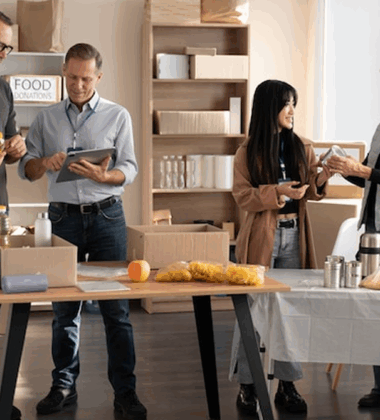At the Food and Beverage Expo USA, the show floor is more than just rows of booths—it’s a stage. And at the center of the most magnetic, traffic-stopping exhibits are not always brands or banners, but chefs. In recent years, we’ve seen a shift in how culinary professionals are positioned at trade shows: not just as food preparers, but as brand storytellers. Welcome to the era of chef branding, where personality, performance, and plate come together to drive consumer connection and purchase intent.
This article explores how live food demos and culinary performances are transforming chefs into brand ambassadors, storytellers, and even influencers. We’ll break down how chef branding works, why it drives audience engagement, and how you can implement a strategy that elevates your presence at food expos, especially one as influential as Food and Beverage Expo USA.
From Kitchen to Spotlight: Why Chef Branding Matters
Chefs today are no longer just behind-the-scenes artisans. With the rise of culinary media, cooking competitions, and social content, chefs have become front-facing brand assets. Their expertise, charisma, and storytelling ability can be powerful tools for driving booth traffic and product credibility.
But chef branding isn’t just about being recognizable. It’s about aligning the chef’s personality, values, and culinary perspective with the brand they’re representing. When done correctly, this strategy transforms passive demonstrations into active brand storytelling moments.
Why Expo Audiences Respond to Chefs:
- Trust factor: Chefs are seen as authorities on taste, quality, and food trends.
- Entertainment value: Live cooking performances draw crowds and create immersive experiences.
- Emotional storytelling: Chefs often connect products to origin stories, heritage, and personal passion.
- Sampling with context: Tastings become more memorable when paired with a narrative from a chef.
Case Study: From Demo to Demand – Chef Nadia at Booth 312
Brand: PureOrigins Plant-Based
Chef: Nadia Morales, Vegan Cuisine Expert
Event: Food and Beverage Expo USA, 2024
Challenge: Launching a new line of dairy-free sauces in a crowded marketplace where plant-based options are increasingly common.
Approach:
Instead of relying on static displays and passive sampling, PureOrigins brought in Chef Nadia Morales to create a live culinary stage experience. Every hour, she prepared small dishes using the sauces—ranging from coconut Alfredo gnocchi to chipotle aioli tacos—while narrating the development process, sourcing stories, and pairing recommendations.
Key Branding Moves:
- Uniformed chef station with subtle PureOrigins branding
- Large LED screen with close-up camera shots of plating
- Audience Q&A after each demo to increase interaction
- Live polling via QR codes to rate taste and ask questions
Results:
- 4x higher foot traffic during demo hours
- 62% of attendees stayed for more than 5 minutes
- 1,500+ QR scans over three days
- Surge in post-event online orders, tied to retargeted ads featuring Chef Nadia
Why It Worked: Chef Nadia wasn’t just a cook—she was a storyteller. Her deep passion for plant-based food, her personal anecdotes about recipe development, and her engaging on-stage presence made the brand feel human, values-driven, and memorable.
Building a Chef Branding Strategy
To leverage chef branding at an expo, especially a high-traffic event like the Food and Beverage Expo USA, you need more than a skilled cook. You need a cohesive plan that ties together performance, brand identity, and consumer engagement.
Step 1: Choose the Right Chef
Look for a culinary personality whose:
- Philosophy aligns with your brand values (sustainability, indulgence, health, etc.)
- Style complements your product line
- Comfort level with public speaking or performance is strong
Partnering with a culinary school or local talent incubator can be a cost-effective way to find emerging chefs eager for exposure.
Step 2: Define the Narrative
Chef branding thrives on storytelling. What story are you telling through the food?
- Is it about heritage and tradition?
- Innovation and technology?
- Sustainability and local sourcing?
Make sure your chef is equipped to weave this narrative into their demonstration organically.
Step 3: Design the Performance Experience
The stage setup matters as much as the food. Think like a producer:
- Use cameras and screens for visibility
- Provide mics so the chef can explain each step clearly
- Add aroma diffusion, plating theatrics, and lighting to draw attention
- Incorporate signage with key talking points or QR codes to follow along
Chef Branding Beyond the Booth
Your chef’s influence shouldn’t end when the last tasting cup is handed out. Maximize impact with multi-channel chef branding that extends beyond the expo:
1. Pre-Event Promotion
- Feature the chef in your email marketing (“Meet Chef Daniel at Booth #452”)
- Share behind-the-scenes footage of recipe creation
- Host a pre-expo Instagram Live with the chef answering audience questions
2. Live Coverage
- Stream demos live on social media
- Let attendees take photos with the chef
- Use branded hashtags and geotags for visibility
3. Post-Event Content
- Release “Chef’s Picks” or a digital recipe booklet
- Share a recap video or testimonial series
- Publish a blog post on “What Our Chef Learned from the Expo”
The chef becomes a continuous touchpoint in your customer experience journey, not just a one-time attraction.
Measuring the ROI of Chef Branding
Because live chef performances are often more resource-intensive, you’ll want to measure their impact carefully. Look at metrics such as:
- Dwell time during demos
- Product sales linked to demo hours
- Social engagement from chef-related posts
- Post-demo signups or purchases
- Media mentions or influencer coverage tied to the chef
Using tools like QR code tracking, digital coupons, and audience polls can help you collect clear, actionable data.
Why Culinary Schools Are Leaning In
Chef branding isn’t just for established professionals. Many culinary schools are integrating trade show performance and brand partnerships into their curriculum. For students, it’s a chance to:
- Learn real-world marketing
- Build a personal brand
- Network with companies and media
For brands, partnering with culinary schools provides access to passionate, hungry talent ready to deliver dynamic live demos while staying cost-efficient.
The Future of Chef Branding at Trade Shows
As consumer expectations continue to evolve, the days of passive product display are fading. Today’s attendees want to be entertained, educated, and emotionally engaged. A well-branded chef can deliver all three—through taste, story, and showmanship.
At events like Food and Beverage Expo USA, where competition is fierce and attention spans are short, a charismatic, story-driven chef performance could be your brand’s most valuable differentiator.
Invest in the right chef. Build a compelling narrative. Deliver a performance that lives beyond the show floor. This is how chef branding transforms your product from a sample into a sensation.





